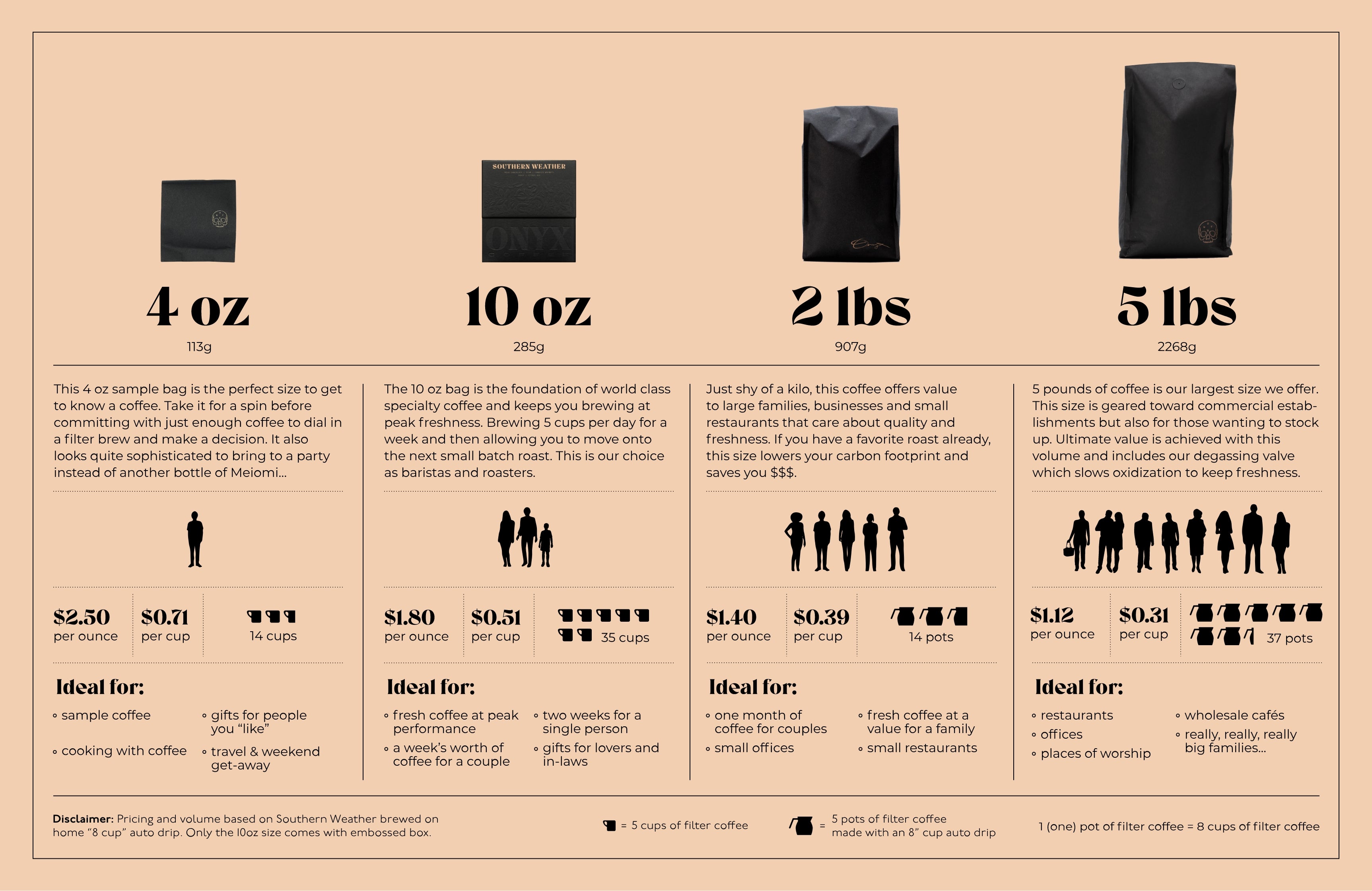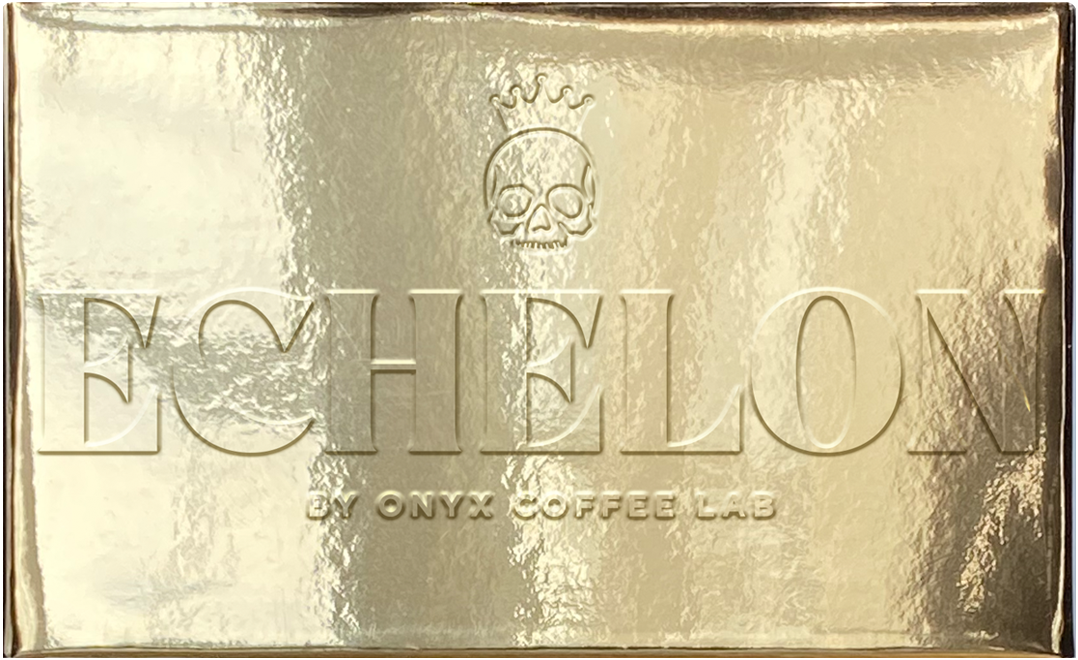Story
We started this journey in coffee ten years ago, holding in our hearts passion and desire to create something truly beautiful and special in coffee. We didn’t really know what that meant, but wanted to push what we thought coffee could be, what we thought community in coffee could be. Our dream was to connect the dots between producers and coffee drinks, between roaster and baristas. This dream has grown beyond what we could have imagined. Our team at Onyx has buoyed us along the way, proving not to just be good but actually great inside of coffee at a whole. And you, our customers have gone with us, believed in what we are doing, laughed and cried with us, and helped push coffee into its next great iteration. The choices we make along the way matter. Thank you for choosing us. Cheers to the next ten years #neversettle
BLEND APPROACH
We started this journey in coffee ten years ago, holding in our hearts passion and desire to create something truly beautiful and special in coffee. We didn’t really know what that meant, but wanted to push what we thought coffee could be, what we thought community in coffee could be. Our dream was to connect the dots between producers and coffee drinks, between roaster and baristas. This dream has grown beyond what we could have imagined. Our team at Onyx has buoyed us along the way, proving not to just be good but actually great inside of coffee at a whole. And you, our customers have gone with us, believed in what we are doing, laughed and cried with us, and helped push coffee into its next great iteration. The choices we make along the way matter. Thank you for choosing us. Cheers to the next ten years #neversettleThere’s a bit of a blending renaissance going on in specialty coffee. For years, blends throughout the industry have been relegated to 83-85 point coffees, a sort of workhorse coffee that serves to create more margin in the roasted coffee business. Within the competition world there’s been a movement to create high end blends of coffee, oftentimes with Gesha varieties, and with the famed Eugenioides to enhance sweetness. This perspective is not new to competition or blending, but has made its way into more mainstream blends. In the early stages of planning this special offering for our tenth anniversary, the thought was to create a blend that reflected the coffees that stood out over the ten years. As we thought of different coffees that might blend well together, we gravitated towards blending our Colombia Tio Conejo Gesha Honey with a washed Ethiopia heirloom variety. It worked well as a concept, as Gesha is a cultivar from Ethiopia heirloom itself, with the terroir of variety reflected with the delicate florals and ripe stone fruit in the cup. The blend works well in practice as well, as you’ll find upon first brew. The honey processed Gesha brings elegant florals and a ripe sweetness from both the processing as well as the variety, with the Ethiopia Worka Chelbessa bringing a tight sweetness as well as a tart citric acidity. This blend is elevated in concept and practice, simultaneously accessible and refined.
COLOMBIA TIO CONEJO GESHA
High in the mountains of Caldas, Colombia, the people of Tío Conejo grow coffee under the shared values of wit and tenacity, and community. This commitment to traditional values drives them to produce some of the best coffee possible. Located on the rich volcanic soils on the outskirts of Manizales, the farm sits at soaring heights of 2,000 MASL. This high elevation contributes to the slow maturation of the coffee cherry development and is paired with holistic and careful agronomy practices to produce the highest quality coffee. It is clear that shared values and community are at the heart of everything done on the farm, which is why they chose the icon of the Tío Conejo to represent the farm. The Tío Conejo is a folklore symbol in coffee production, symbolizing traditional values and the tenacity of coffee producers.
HONEY PROCESSED COFFEE
Honey processed coffees are tricky. Oftentimes the result of this process ends up being the same as if they were washed, but other times they end up much worse. The process begins much like washed coffee, where the cherries are depulped, but then the process is halted. Instead of sending the seeds to the fermentation tanks where yeast and microbes break down the sticky mucilage, the honey processed coffee is sent straight to the drying bed, where they’re pop dried with the mucilage left on. This leaves some of the fruit left partially on, ideally imparting some sucrose and fructose as it continues to ferment (slowly, in this case). The honey process gets its name from the sticky fruit left on the outside of the seed, but it is easier to think about when it’s referred to as a ‘pulped natural,’ or even ‘partially washed.’ Differing levels of fermentation and even the type of depulper used to strip the cherry from the seed can influence the color of the dried coffee. As the process's popularity has spread, new names for the levels of processing have spread with it. You will see the levels generally follow the trend from white honey, all the way to black honey. When we spoke with Ivanov about this processing method, he classified this honey as red honey. Prior to depulp, they pre-ferment the whole cherries in Ecotac bags, limiting oxygen and kickstarting the yeast and microbes to begin their work.
White honey usually follows the trend that most of the mucilage is removed, followed by a light and short fermentation with rigorous movement during drying. This exposes most of the parchment on the seed, which is a yellow to white color.
Yellow honey has a bit more mucilage left on the seed, as well as a bit more activity in fermentation. The mucilage left on will turn a golden yellow color as the oxidation of fermentation takes place. These are usually shade-dried and turned just a few times per day of drying.
Red honey has much of the seeds mucilage left on, with just the thin cherries skin removed during depulp. Heavily laden drying beds or patios become difficult to turn with the large mass of sticky fruit and seeds, which creates the perfect conditions for the slow oxidation and lots of microbial activity. All this activity, combined with the fruit left on the outside of the seed, turns the dried parchment a rusty red color.
Black honeys are considered the most ‘fermented’ of the honey process. This is when the terroir of the coffee takes a bit of a backseat, as the sugars from the fruit ferment and impart a winey flavor and heavier texture to the cup. Black honey coffees are seldom moved on the drying patios or beds, where they are fermented for extended periods of time. During this slow fermentation, the mucilage goes through all the phases listed above, before it transitions from a rusty red to a red-black color.
ETHIOPIA WORKA CHELBESA
This coffee’s journey began in an unlikely place: Minnesota. Negusse Debela visited a specialty coffee cafe and had a revelation over how diverse and sweet a cup of coffee can be. From this moment, Negusse began to explore coffee back home in the Yirgacheffe region of Ethiopia. He experienced the tradition of growing and processing coffee, and understood how to improve and move coffee forward in his home. From this journey, SNAP specialty coffee was established in 2008, aiming to supply high-end specialty coffee, facilitating a similar experience that Neguesse had in Minnesota years ago.
From its wetmill in Gedeb, SNAP works with 486 smallholder producers to produce complex and floral coffees that are outstanding examples of what Yirgacheffe coffees can be. SNAP operates in Gedeb with their vertically integrated Veer Trading Company. The work that is put into processing these coffees is upheld by their dry mill in Addis Ababa. After each harvest these coffees are sorted by screen size, as well as density. This focus on processing and milling produces extremely stable and delicious coffee each season.
WASHED PROCESSED COFFEES
The washed process begins with coffee cherries delivered to the washing station, both from the primary market or from farmers bringing their coffee directly to the mill. The cherries are inspected, and an initial quick round of hand-sorting separates the defective coffees before placing them into the hopper. They are then funneled to the disc pulper, which removes the fruit from the seeds (beans). After that phase is done, the coffee is fermented underwater for approximately 36 hours, with the water drained and refreshed once in that cycle. Then, the parchment is emptied into the washing channels, where it is agitated with rakes. During this step, the water is refreshed twice. Once the washing is complete, the coffee undergoes the traditional “double wash,” where it rests in the soaking tank for another 12 hours, before being taken to the raised drying tables for sun drying.



